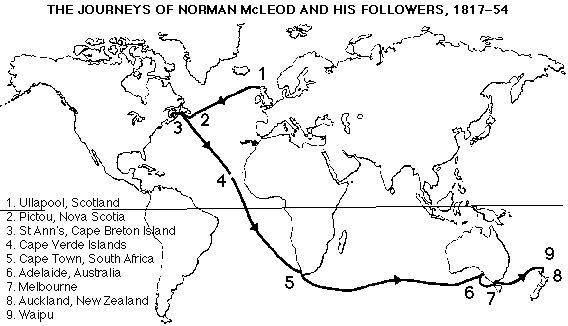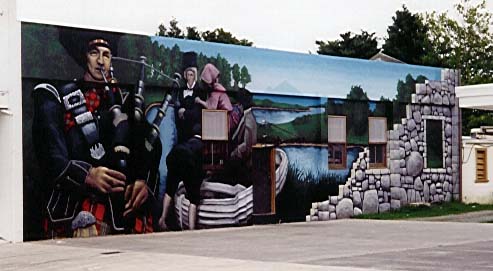|

Check
out the Waipu Museum Web Site
The story begins with
Norman McLeod, born in 1780 at Stoer Point, Assynt Parish,
Sutherlandshire in the Highlands of Scotland. As a young man he
underwent a religious conversion and determined to become a minister of
the established Church of Scotland. After studying for the ministry at
the University of Edinburgh, he became disillusioned with his
instructors and broke off his studies. He returned to the Highlands to
earn his living as a teacher. He taught in his home parish and in
Ullapool in Ross-shire. In each parish, he began to preach and criticise
the incumbent ministers for their hypocrisy and immorality, drawing
crowds of parishioners away from the established Church. He was removed
from both of his teaching positions.
After fishing for two
years out of Wick in Caithness, he emigrated in 1818 to Pictoa, Nova
Scotia, on the Frances Aini. While traversing the Atlantic Ocean,
the ship sprang a leak. The Captain was about to turn back towards
Ireland when McLeod calculated that they were closer to Nova Scotia than
Great Britain. The ship carried on under McLeod’s direction and made a
safe landfall.
In Pictou McLeod once
again drew large crowds with his preaching. He made many enemies by
criticising the ungodly ways of the townspeople. He decided to move to
Ohio whence he had been invited by a group of Highlanders. Along with
his kinfolk and converts he built a ship, named the Ark, and set out. A
storm blew the Ark into St Ann’s harbour, Cape Breton Island.
The travellers, impressed with the bounteous fishing and the providence
which had brought them there, decided to stay.
After many successful
years in St Ann’s, during which the community prospered, potato blight
and wheat rust attacked the crops of Cape Breton in 1847. People were
reduced to starvation. Late in 1848, McLeod received a letter from his
son Donald who had emigrated to Australia. The letter spoke in glowing
terms of the climate and conditions of that continent. The people of St
Ann’s decided to build a ship so that they could move there. As more
and more people became interested in emigrating, a second ship was built
by the brothers Duncan and Murdoch McKenzie from the neighbouring
community of Bad-deck. The ship from St Aim’s was called the Margaret
after McLeod’s youngest daughter. The McKenzies’ ship was named
the Highland Lass.
In 1851 the Margaret sailed
from Cape Breton. She was followed six months later by the Highland
Lass. The ships, carrying 300 migrants in all, arrived in Australia
at the height of the Victoria gold rush. The emigrants found that good
coastal land was available only at exorbitant prices. After a number of
their group, including three of Norman McLeod’s sons, died in a
typhoid epidemic, it was decided that they should leave Australia and
try to obtain land in New Zealand.
The first group of Nova
Scotians arrived in Auckland in September 1853. They immediately
petitioned the government for a block of land on which they could settle
together. Four ships followed from Nova Scotia, the Gertrude in
1856, the Spray in 1857, the Breadalbane in1858, and
the Elten Lewis in 1858. In addition, eight families came
directly from Scotland to join relatives from Cape Breton. In all more
than 800 people took part in the migration. While most settled at Waipu,
others formed sister settlements at Whangarei Heads, Leigh, Okaihau and
the valleys north of Whangarei - Kamo, Whau Whau, Hukeranui and
1-Tikurangi - linking the far north in a web of kinship and community.
Reference: Molloy, Maureen, 1991,
"Those Who Speak to the Heart - The Nova Scotian Scots At Waipu
1854-1920" Dunmore Press Ltd, New Zealand. (ISBN 086469 130 0)
and thanks to Dell Purdie
for hunting this out for us.

Mural on the Butchers Shop in Waipu
|

